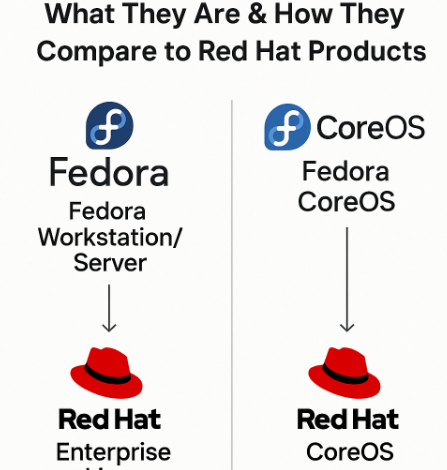
Fedora vs Fedora CoreOS = Redhat?
Fedora vs Fedora CoreOS: What They Are & How They Compare to Red Hat Products
In the world of Linux, the Fedora Project stands as a gateway to the cutting edge of open-source innovation. Sponsored by Red Hat, Fedora offers not one, but two powerful operating systems tailored for very different use cases: Fedora Workstation/Server and Fedora CoreOS. While they share the same upstream ecosystem, each serves a distinct purpose—and both play vital roles in shaping Red Hat’s enterprise-ready products.
What is Fedora?
Fedora is a free, open-source Linux distribution that serves as a testing ground and upstream source for Red Hat Enterprise Linux (RHEL). It’s community-driven, frequently updated, and ideal for developers and Linux enthusiasts who want access to the latest features first.
Fedora is divided into multiple editions, including:
- Fedora Workstation: Desktop-focused, sleek, and developer-friendly.
- Fedora Server: A minimal, enterprise-grade server OS.
- Fedora CoreOS: An automatically updating, minimal OS designed for containerized workloads.
Fedora Workstation / Server vs. Red Hat Enterprise Linux (RHEL)
| Feature | Fedora Workstation/Server | Red Hat Enterprise Linux (RHEL) |
|---|---|---|
| Release Cycle | Short (approx. every 6 months) | Long (approx. every 3–5 years with 10+ years of support) |
| Stability | Bleeding edge / experimental | Rock-solid / production-tested |
| Use Case | Development, testing, personal use | Enterprise production environments |
| Support | Community support | Paid support from Red Hat |
| System Updates | Frequent and rapid | Controlled and security-focused |
| Cost | Free | Subscription-based |
Fedora → RHEL: RHEL is built from Fedora’s stable innovations. New features tested in Fedora eventually make their way into RHEL after rigorous hardening and validation.
Fedora CoreOS vs. Red Hat CoreOS
| Feature | Fedora CoreOS | Red Hat CoreOS (RHCOS) |
|---|---|---|
| Purpose | General-purpose, automated container OS | Purpose-built for OpenShift Kubernetes clusters |
| Update Strategy | Automated updates via rpm-ostree | Managed and tightly integrated with OpenShift lifecycle |
| Use Case | DIY Kubernetes, container platforms, labs | Enterprise-grade OpenShift clusters |
| Customization | User-controlled Ignition configs | Controlled and tested with Red Hat releases |
| Stability | Fast-moving, experimental | Hardened and certified for production |
| Cost | Free | Included in OpenShift subscription |
Fedora CoreOS → RHCOS: Like Fedora Workstation leads into RHEL, Fedora CoreOS is the upstream project for Red Hat CoreOS. It allows users to experiment with next-gen container deployment strategies, which are eventually integrated into OpenShift environments.
Why It Matters
Whether you’re a developer experimenting with new ideas or a business deploying production workloads at scale, Fedora and Red Hat offer a pathway to success:
- Fedora = Innovation: Try new technologies early.
- RHEL = Reliability: Run mission-critical workloads with full support.
- Fedora CoreOS = Flexibility: Build custom container-native platforms.
- Red Hat CoreOS = Security: Deploy hardened, managed infrastructure with Kubernetes/OpenShift.
Use Them in Training or Lab Environments
At LT&P Technologies, we use Fedora and Red Hat systems in our Linux training tracks to give students real-world, enterprise-relevant experience:
- Fedora Workstation for beginner-friendly Linux desktop training.
- Fedora CoreOS for DevOps and Kubernetes labs.
- Red Hat RHEL-based labs for students preparing for RHCSA, RHCE, and OpenShift certifications.
Ready to Learn More?
Whether you’re diving into Linux for the first time or advancing toward enterprise DevOps certifications, understanding Fedora’s role in the Red Hat ecosystem helps you stay ahead.
🔗 Contact us to enroll in one of our Zero-to-Hero Linux programs.



